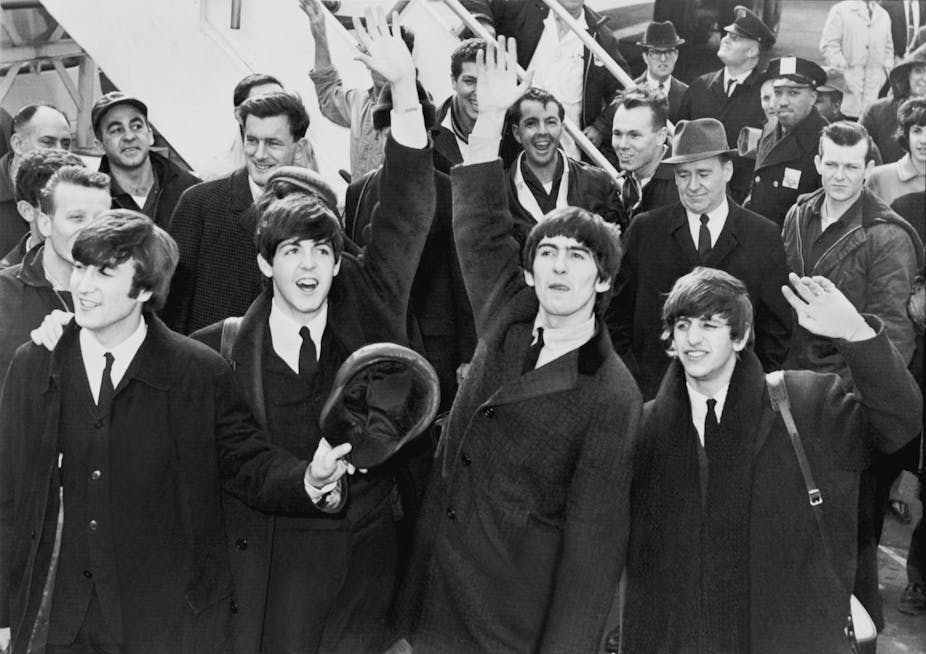Fifty years after the Beatles first appeared on the Ed Sullivan Show, the band is still the benchmark for Anglo-American relations. With their swift rise to fame in the US, they started the so-called British Invasion of American music. Until their triumph it had always been a one-way street of influence, from America to Britain.
Before the Beatles, American music was suffering from a post-rock ‘n’ roll hangover. But due to slow transport and communication links at the time, Britain was enjoying a rock boom in the late 1950s and early 1960s. Elvis continued to have massive hits during his career. Buddy Holly had numerous posthumous Top 20 hits in UK, though none in the US. Yet almost no British musician could crack America. Even the beloved Cliff Richard had only one minor Top 40 in the decade.
But with “I Want to Hold Your Hand” having just reached the top of the American charts earlier in the week, from the moment they first landed, with 4000 screaming fans waiting at the newly-renamed JFK airport in February 1964, there was something special about the Beatles. They turned the US and British music scenes on their Cuban-heeled boots. They started the first case of American Anglophilia in popular culture in decades. In both countries there was a rush to imitate, copy or rebel against them.
British Invasion
Immediately after the Beatles had their first American hits, the radio waves opened to other British groups. Bands ranging from Beatles soundalikes Peter & Gordon to the brasher Dave Clark Five and the Rolling Stones found success in the States. Suddenly Americans could not get enough of British sounds and styles.
Partly because the Beatles wore collarless suits and had mop top hair, fashion became an essential piece for musicians. Some groups, such as Billy J Kramer and the Dakotas, copied the same clean-cut image of the Beatles. Others, like the Rolling Stones, went for the arrogant, unkempt style, leading to famous headlines in the press. Long hair was not only accepted, it became required.
For both men and women, Carnaby Street was the fashion capital of the world. The mini – both skirt and car – became a symbol for Swinging London, with the Beatles as its rulers. For most of the decade the Beatles, and most British artists, were more concerned with fashion than politics. In Revolution 1, the band showed their political ambivalence. So too, with the Rolling Stones’ Street Fighting Man.
American Reactions
In the US, British-fever happened almost immediately. The Billboard number one songs during 1964 were almost entirely either the Beatles, other British artists or Motown groups. New groups popped up immediately to copy and respond to the sounds of the fresh, lively lads from Liverpool. The Beau Brummels believed that having a British-sounding name, with a spelling similar to the Beatles, would make the public buy their records. So too did the Sir Douglas Quintet, from Texas.

Perhaps the two most famous groups to emerge because of the Beatles were the Byrds and the Monkees. Byrds founder and guitarist Roger McGuinn once said that after seeing the Beatles film A Hard Day’s Night the group knew they needed to change their sound and style. They grabbed the Rickenbacker 12-string guitar George Harrison had used in the movie and made it their own. They grew their hair long and found McGuinn’s famous “granny glasses”. On a trip to London they spent hours shopping for the latest Carnaby fashions. On looks alone they could have been the second coming of the Beatles.

The Monkees, too, could have been the Beatles. The group starred in a television show of the same name which was intended to be a spoof of A Hard Day’s Night. It saw the actors become musicians in their own right. That the actor-musicians ran around in a similar way to early Beatles antics did not harm the ratings of the show, nor their record sales.
Yet, whereas most British groups were apolitical, many American artists used music to provide social commentary. The Byrds produced Turn! Turn! Turn! and the Monkees had Randy Scouse Git, renamed Alternate Title for the UK audience. It was the Vietnam War, however, that inspired the most commentary from American artists, in everything from folk to psychedelic.
Anglo-American relations today
The Beatles opened up the American pop market, and there has been a British presence there since. There have been British highs, ranging from the supremacy of Led Zeppelin and heavy metal in the 1970s, to lows during the early 1990s and the dominance of grunge. There is now regular traffic going back and forth across the Atlantic, with artists having hits in both countries on a regular basis.
More than just in music, however. From Harry Potter, Sherlock and Adele to Law & Order, The Simpsons and Katy Perry, popularity in one country often translates to popularity in the other. Before the Beatles, it had only ever been Americans liked in Britain, not the other way around. That’s why, 50 years after their most famous American television appearance, the two surviving Beatles played the Grammys, and received Lifetime Achievement Awards: for breaking down that transatlantic barrier.

